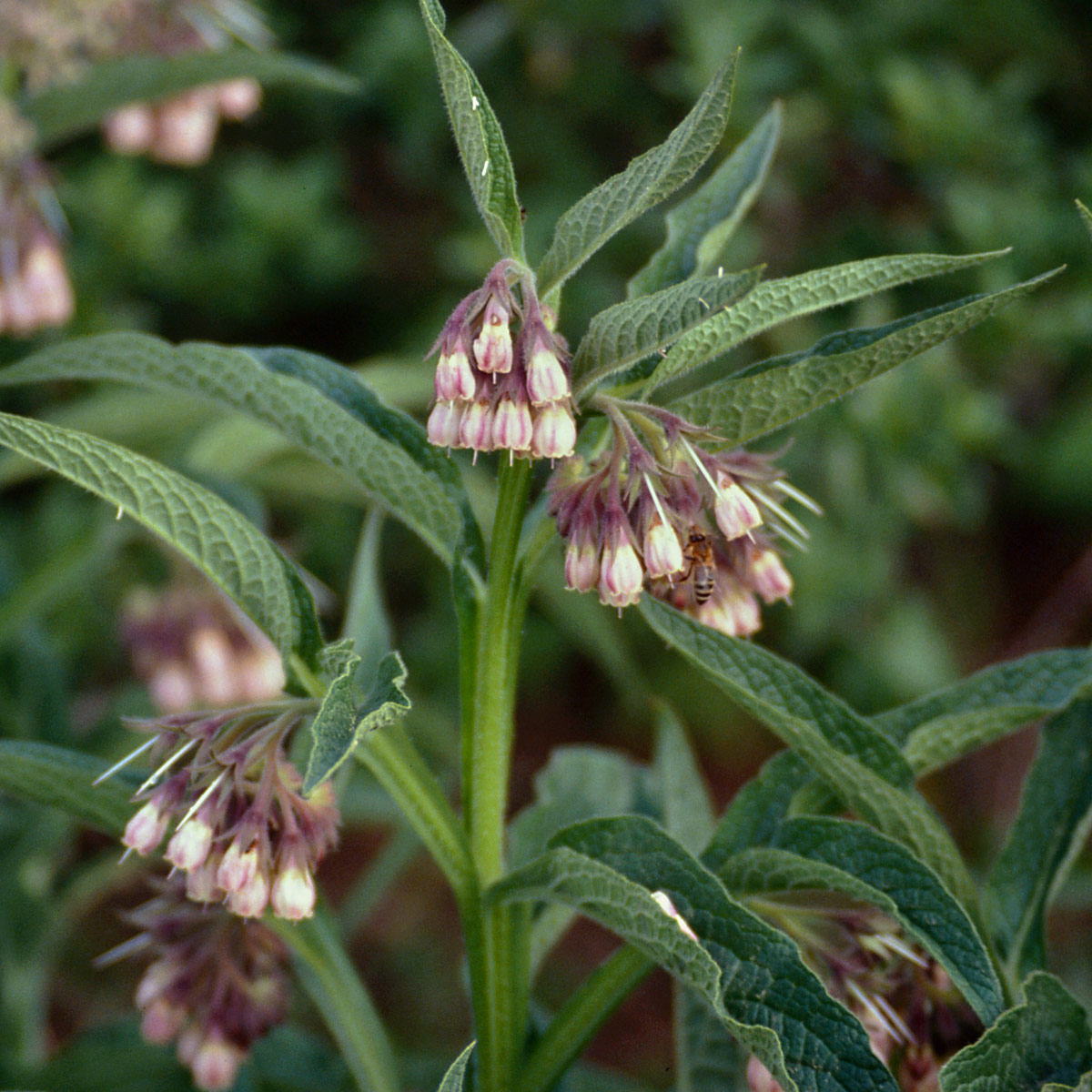Botanical name
Symphytum officinale L.
Family
Boraginaceae
Common name
Comfrey, Common comfrey, Blackwort, Knitbone
Information about the plant
Comfrey is native to Eurasia and extends eastward to Central Asia. It grows in damp meadows, along ditches and banks. It is now also widespread in North America.
The genus name Symphytum is derived from the Greek 'syn' (= together) and 'phyo' (= to grow), from which the Greek 'symphytos' (= grown together) originates. This describes the fusion of wounds or even bones, making it a wound-healing agent. This healing power is also expressed in the German name of the plant ’Beinwell’, because in ancient medicine ’die Wunde wallt’ meant ’the wound grows closed’ or ’heals’. Comfrey is therefore a very old medicinal plant, which is made clear in the epithet officinale, because officinalis means ‘commonly used in the pharmacy’, derived from ‘officina’, the salesroom of a pharmacy.
Comfrey grows to a height of 50 to 100 cm and is anchored up to 30 cm deep in the ground by a turnip-shaped, thick taproot. It is a semi-rosette perennial with a branched, heavily bristly-haired stem. The leaves are ovate-lanceolate and long-pointed, with the upper leaves narrowing to a winged petiole running far down the stem. The leaf veins are also rough-haired. In the axils of the upper leaves are the purple or red-purple (also yellow-white), bell-shaped, nodding flowers arranged in dense-flowered double clusters. The calyxes have teeth, and the petals form a tube with several hairs on the outside. Flowering time is from May to July.
Medicinally used parts of plants (herbal drug)
The dried roots (Comfrey root – Symphyti radix) are used. The commercially available drug comes from cultivations.
The dried herb of S. x uplandicum Nym. (Comfrey herb - Symphyti herba), is also medicinally used, imported from Eastern European countries.
Constituents of the herbal drug
Comfrey root and comfrey herb contain tannins, mucilages, caffeic acid derivatives (including rosmarinic acid), allantoin and pyrrolizidine alkaloids. Since the latter are toxic to the liver, low-pyrrolizidine alkaloid cultivars are used for the production of finished medicinal products.
Quality of the drug
The pharmacopoeias (Ph. Eur., DAB, DAC) do not specify the quality of either comfrey root or comfrey herb.
Medical applications
Recognised medical use
Comfrey root (S. officinale)
The HMPC has classified comfrey root as a traditional herbal medicinal product (see Traditional Use).
ESCOP: externally for pain and swelling of muscles and joints; also for joint arthrosis, acute back pain, muscle strains, bruises and sprains, epicondylitis, tenosynovitis and periarthritis. These areas of application are based on findings from long-standing use on humans.
Commission E: externally for bruises, pulled muscles and ligaments, and sprains. Clinical studies have proven the following areas of application (approval): for painful muscle and joint complaints, bruises, strains, sprains (after the acute phase has subsided), and to promote local circulation.
Comfrey herb (S. uplandicum)
The following indications have been proven by clinical studies (approval): externally for bruises and sprains (in sports and accident injuries), muscle and joint pain due to blunt injuries.
Traditional use
Comfrey root has been classified by the HMPC as a traditional herbal medicinal product (§ 39a AMG). Based upon long-standing use, comfrey root can be used externally for sprains and minor bruises.
Herbal drug preparations in finished dosage forms
Symphytum officinale – root
- Powdered comfrey root for the preparation of an infusion or a paste
- Fluid extract in ointments, creams and poultices
- Fresh plant pressed juice combined with the alcoholic extract from the press residue
Dosage
To ensure efficacy and safety, comfrey root and comfrey herb should be used in the form of finished medicinal products; the dosage can be found in the patient information leaflet.
Preparation of a tea
For external use in the form of a poultice, 5 to 10 g of coarsely powdered comfrey root is boiled with 100 mL of water and passed through a sieve after 15 min. A warm comfrey root paste is prepared by mixing the coarsely powdered drug with a little hot water.
Notes
Apply only on intact skin!
Comfrey preparations must not be used during pregnancy and lactation, or in children under 3 years of age due to lack of evidence.
Although the pyrrolizidine alkaloids do not enter the bloodstream when applied to intact skin, comfrey should not be used for more than 4 to 6 weeks per year. However, the extracts processed into finished medicinal products are prepared using special processes that eliminate the pyrrolizidines. For such products, there is no restriction in the duration of use.
Side effects
None known
Interactions
None known


